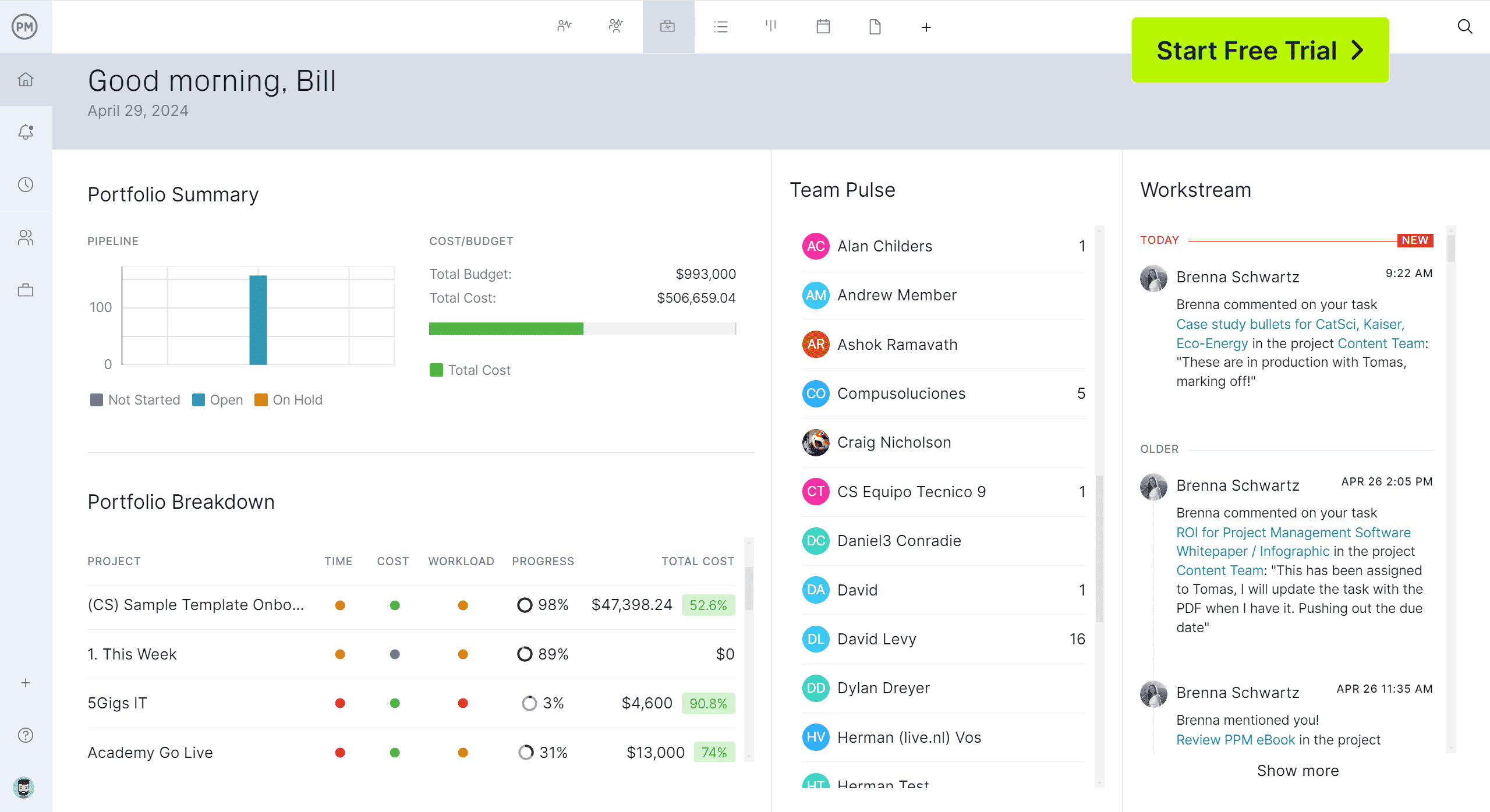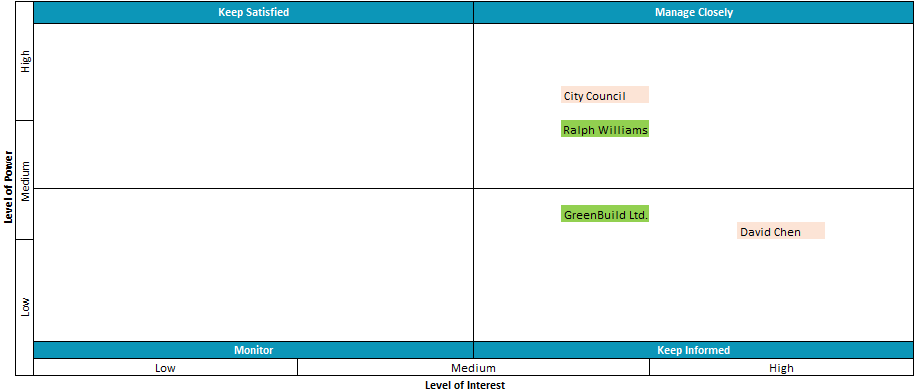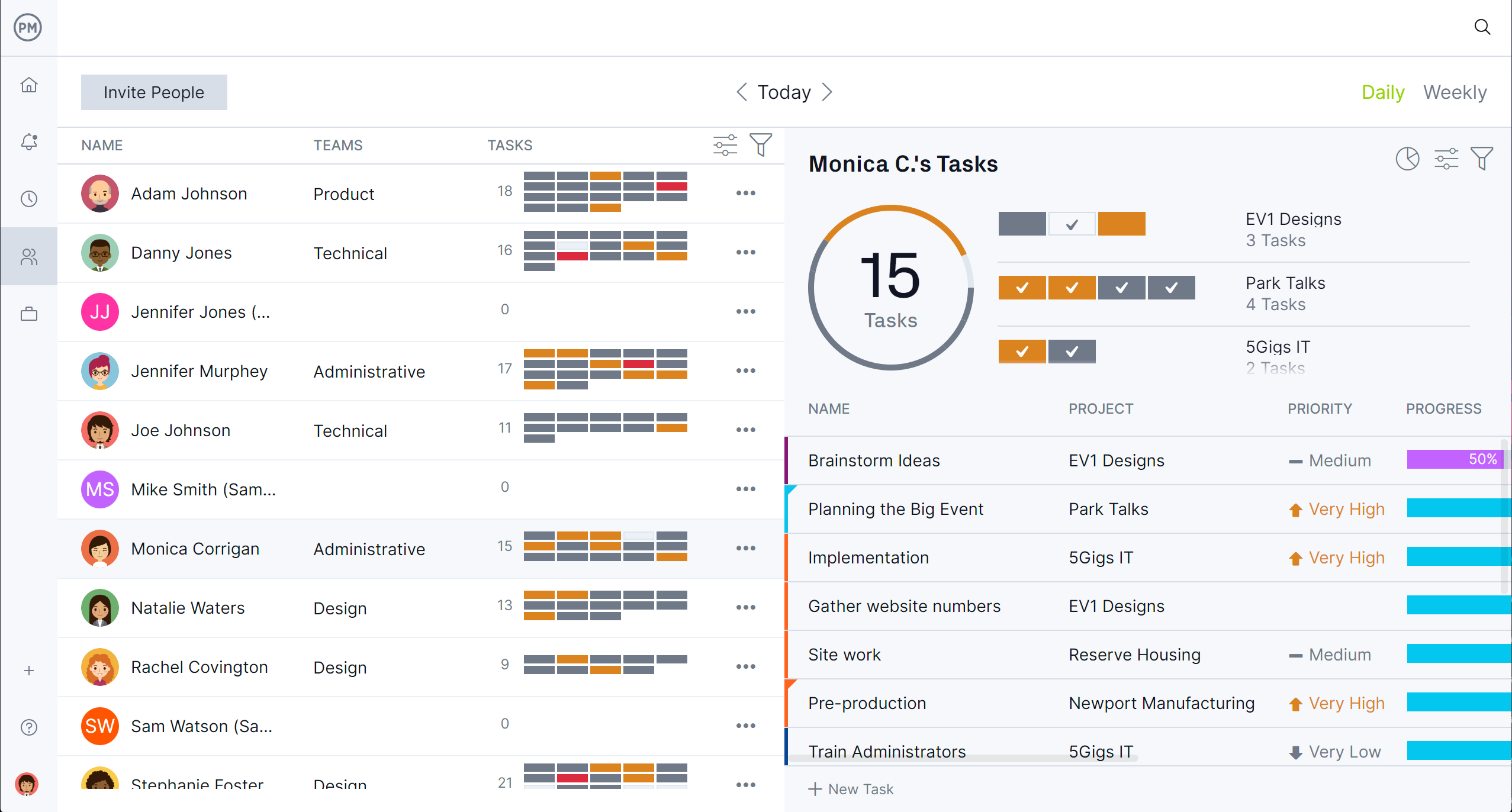Managing stakeholders is one of the most important parts of running a successful project. Every initiative involves people with different levels of interest and influence, from clients and executives to suppliers and end users. A stakeholder matrix helps project managers see these relationships clearly so they can focus attention where it matters most. When you can visualize who needs regular updates, who should be kept satisfied and who might block progress, you can make better decisions and avoid costly surprises.
Using a stakeholder matrix keeps communication targeted and efficient. Instead of guessing who to involve at different stages, you can prioritize stakeholders based on their impact on the project’s outcome. This leads to stronger collaboration, fewer delays and smoother approvals. The right stakeholder matrix template makes the process simple and repeatable so your team stays aligned from kickoff to delivery.

Get your free
Stakeholder Matrix Template
Use this free Stakeholder Matrix Template for Excel to manage your projects better.
What Is a Stakeholder Matrix?
A stakeholder matrix is a visual tool that helps project teams categorize stakeholders based on their level of interest and influence in a project. It typically places stakeholders on a grid, making it easy to see who has the most power to affect the project and who needs the most communication. By using a stakeholder matrix, project managers can focus their time and resources on the people who matter most, ensuring that expectations are managed and support is secured.
This tool is especially useful for complex projects with many participants. It reduces the risk of overlooking key voices, helps anticipate where resistance might occur and guides the team in creating targeted engagement strategies. A well-built stakeholder matrix provides clarity early in the project lifecycle, which helps minimize conflict and keeps everyone aligned on goals.
Project management software centralizes stakeholder information, communication history and engagement plans in one place. This makes it easier to keep track of who needs updates, assign tasks related to stakeholder outreach and monitor the impact of stakeholder actions on the project timeline. Real-time dashboards, reporting features and document sharing ensure that every interaction is logged and accessible, helping teams maintain transparency and consistency.
ProjectManager is built to work seamlessly with a stakeholder matrix, giving teams multiple project views, including Gantt charts, kanban boards and dashboards, to monitor stakeholders alongside tasks and milestones. We have unlimited free guest licenses to keep stakeholders informed on progress without using a paid license. By combining stakeholder mapping with robust resource management and tracking tools, our software helps teams build stronger relationships and keep projects on schedule. Get started with ProjectManager today for free.

What Should Be Included in a Stakeholder Matrix?
A stakeholder matrix should include each stakeholder’s name, role, level of interest and level of influence so project managers can see at a glance who needs close management and who only needs occasional updates. It can also capture communication preferences and engagement strategies to make outreach more effective. By including these key details, the matrix becomes a practical tool that guides decision-making and keeps teams aligned with stakeholder expectations.
1. Stakeholder Identification
Stakeholder identification lays the groundwork for an effective matrix. It begins by recognizing everyone who can influence or be affected by the project and clarifying their role in relation to it. This process ensures no key group is missed and helps distinguish between those directly involved and external parties such as regulators, suppliers or customers.
- Name/Group: Identify individuals, teams or organizations.
- Role/Position: Note their function in the project.
- Category: Specify whether they are internal (employees, management) or external (customers, regulators, community).
Related: 5 Stakeholder Map Examples With Analysis
2. Stakeholder Attributes
Attributes highlight what makes each stakeholder relevant and how they connect to project outcomes. These factors reveal what drives them, how much influence they wield and the degree to which the project affects them. Capturing these qualities allows project managers to anticipate challenges and design strategies aligned with stakeholder priorities.
- Interests: Key expectations or concerns.
- Influence/Power: Ability to shape project decisions.
- Impact: Positive or negative effect of the project.
- Support/Attitude: General stance—supportive, neutral or resistant.
Related: 13 Free Stakeholder Management Templates for Excel & Word
3. Mapping Dimensions
Mapping dimensions translates the assessment into a clear visualization. By positioning stakeholders on axes such as power versus interest, project teams can quickly see who requires close attention and who can be monitored with less effort. Other models, like influence versus impact or the salience model, provide alternative lenses for analyzing stakeholder relationships.
4. Engagement Approach
The engagement approach defines how the team interacts with stakeholders across the project lifecycle. It covers the flow of information, the type of involvement expected and accountability for maintaining the relationship. By setting this structure, the project team builds trust, reduces conflict and ensures stakeholders remain aligned with project goals.
- Communication Needs: Frequency and channels for updates.
- Engagement Strategy: Planned level of involvement (updates, consultations, active participation).
- Assigned Owner: Person responsible for stakeholder relationship.
5. Assessment Over Time (Optional)
Stakeholder priorities and influence often shift during a project, making regular reassessment valuable. Comparing their current stance with the desired one highlights gaps and informs corrective action. Continuous updates ensure the matrix reflects real conditions and remains an effective tool for guiding engagement.
- Current Status vs. Desired Status: Position now versus where they should be.
- Change Tracking: Notes on how influence, interests or attitudes evolve.
Related: Project Stakeholder Management Plan YouTube Video
When to Use a Stakeholder Matrix
A stakeholder matrix is best used at the start of a project when you’re identifying who will be impacted and who has influence over decisions. It can also be updated at key project milestones when new stakeholders are added or priorities shift. Use it whenever there is a risk of miscommunication or when you need to focus engagement efforts on the most critical people. A stakeholder matrix is helpful during planning, execution and even closing to make sure every stakeholder is informed and satisfied.

Benefits of Using a Stakeholder Matrix
A stakeholder matrix is a powerful tool for managing the people who influence or are affected by your project. By visually mapping stakeholders based on their level of interest and influence, project managers can identify who requires close attention, who should be kept informed and who can be monitored periodically.
Using a stakeholder matrix not only clarifies priorities but also helps teams communicate effectively, reduce risks and maintain alignment throughout the project lifecycle. Here’s a short list of the benefits of a stakeholder matrix.
- Improves communication by showing who needs updates and how often
- Helps manage risk by identifying stakeholders who could delay or block progress
- Builds stronger buy-in by keeping key players engaged at the right time
- Saves time by prioritizing outreach and avoiding unnecessary meetings
- Supports smoother approvals by aligning expectations early
Stakeholder Matrix Template
Download this free stakeholder matrix template for organizing and analyzing stakeholder groups in a project environment. By listing each stakeholder’s name, group and role, teams gain visibility into who holds stakes in the outcome and what their communication needs are.
Columns in the template capture essential attributes such as whether the stakeholder is internal or external, their interests, level of power, influence and impact, plus their attitude toward the project and preferred communication channels. The template helps clarify expectations for progress meetings, technical check-ins and milestone reports so each party stays informed.

Using the attached stakeholder matrix template, teams can rate the level of power and interest for each stakeholder, supporting decisions about management strategies for engagement and oversight. Common classifications like “Manage Closely,” “Keep Satisfied” and “Keep Informed” guide how often and in what style to interact with each group. For example, a high-power, high-interest sponsor might require weekly summaries, whereas a supplier could be updated monthly. This structured approach streamlines stakeholder communication and establishes accountability across project phases.
Stakeholder Matrix Example
To better understand how a stakeholder matrix works, let’s take a look at an example.
Imagine a construction company starting a project to build a new community recreation center. This project involves multiple moving parts: funding, design, compliance, materials and ultimately the people who will use the facility. Each of these aspects ties directly to key stakeholders who influence the project in different ways.
At the top is Ralph Williams, the Executive Sponsor. He represents the company’s leadership and has been instrumental in securing funding for the project. His influence is high and his active involvement ensures the project stays aligned with broader organizational goals.
On the technical side, David Chen from the IT Department plays a critical role. The recreation center will integrate smart systems for energy efficiency and visitor management and David is responsible for making sure these systems work seamlessly.
Externally, the company relies on GreenBuild Ltd., a trusted supplier providing construction materials. Their reliability makes them a supportive partner, but their continued engagement depends on clear agreements and timely payments.
The project also cannot move forward without the City Council, which issues permits and enforces building regulations. Their approval process has a huge impact, making them a powerful stakeholder that must be carefully managed with formal communication.
Finally, the End Users Group, made up of local residents and community organizations, will ultimately benefit from the recreation center. Their input on design and usability is essential to ensuring the facility meets real needs and gains public support.

This example shows how different stakeholders—executives, technical experts, suppliers, regulators and end users—come together in a project. By mapping their interests, influence and communication needs, the construction company can manage relationships strategically and improve the project’s chances of success. The table below shows their level of power, interest, impact, attitude and communication needs.

This is how the stakeholder matrix looks when each of the stakeholders is placed in it.

Related Stakeholder Management Templates
Managing stakeholders effectively requires structured tools to identify, organize and engage everyone involved in a project. Related templates provide a framework for capturing key stakeholder information, prioritizing communication and planning engagement strategies. Using these templates helps ensure no stakeholder is overlooked and that project goals are aligned with stakeholder expectations.
Stakeholder Analysis Template
The stakeholder analysis template helps project managers assess each stakeholder’s interest, influence and potential impact on the project. By categorizing stakeholders, teams can focus on the most critical relationships and develop strategies to address their concerns or leverage their support.
Stakeholder Register Template
The stakeholder register template provides a centralized record of all stakeholders, including their roles, contact information and level of influence. It acts as a reference for the project team to maintain transparency and track engagement throughout the project lifecycle.
Stakeholder Engagement Plan Template
The stakeholder engagement plan template outlines how and when stakeholders should be engaged. It specifies communication frequency, methods and responsibilities, helping teams foster collaboration, manage expectations and address concerns proactively.
How ProjectManager Helps With Stakeholder Management
Managing stakeholders can be complex, especially when multiple parties have differing levels of interest and influence. ProjectManager simplifies stakeholder management by centralizing information, tracking engagement and providing tools to visualize relationships, making it easier for teams to communicate effectively and stay aligned with project goals.
Streamline Resource Management
ProjectManager allows teams to allocate resources efficiently by linking tasks and responsibilities to stakeholders. Managers can assign roles, track workloads and adjust resources in real time to ensure key stakeholders are engaged and project milestones are met. This feature helps prevent bottlenecks and ensures that critical tasks receive the attention they need.

Monitor and Track Stakeholder Engagement
With dashboards and reporting tools, our software provides real-time tracking of stakeholder interactions. Teams can monitor updates, manage communications and evaluate engagement effectiveness. This transparency reduces risks, ensures follow-ups occur and helps teams proactively address concerns before they impact the project.

Related Stakeholder Management Content
A stakeholder matrix is but one tool used in stakeholder management. For readers who are curious to learn more about the topic, below are links to articles on how to make a stakeholder management plan, stakeholder analysis and much more.
- How to Make a Stakeholder Management Plan
- Stakeholder Analysis 101 (Example & Template Included)
- Stakeholder Salience Model in Project Management
- Top 10 Stakeholder Management Skills for Project Managers
- 13 Free Stakeholder Management Templates for Excel & Word
- How to Manage Stakeholder Expectations
ProjectManager is online project and portfolio management software that connects teams. whether they’re in the office or out in the field. They can share files, comment at the task level and stay updated with email and in-app notifications. Get started with ProjectManager today for free.

